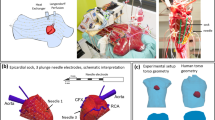Abstract
Background Structural complexities of the intact ventricular wall cause a very complex spread of activation. The effects of regional tissue damage and of antiarrhythmic drugs on directional differences in activation should help to further elucidate intramural conduction patterns.
Methods and results In 10 healthy dogs and in 5 dogs with subacute anterior wall infarction, 6 parallel rows of 6 needle electrodes with 4 bipolar electrode pairs per needle were inserted into the left anterior ventricular wall. Using a computerized multiplexer-mapping system, the spread of activation in epi-, endo- and midmyocardial muscle layers and in the surviving epicardium, respectively, was reconstructed. Marked differences in conduction velocities relative to fiber orientation were evident in the surviving epicardium of infarcted hearts. Directional differences in conduction velocities, although less pronounced, were still preserved throughout the intact ventricular wall. Epicardial transverse conduction in intact hearts was significantly faster than transverse conduction in infarcted hearts (0.87 ± 0.11 m/s vs 0.68 ± 0.1 m/s). In normal hearts, propafenone (2 mg/kg) decreased conduction velocities primarily in longitudinal directions (−27 ± 10%), but also moderately in transverse directions (−13 ± 7%) of all muscle layers, with no significant effect on straight (−4 ± 8%), but on oblique transmural conduction (−33 ± 18%). In infarcted hearts propafenone decreased conduction particularly in longitudinal direction (−23 ± 14%) without affecting conduction transverse to the fiber orientation (+3 ± 6%).
Conclusions Longitudinal intramural shortcircuits reduce directional differences in activation. Transmural infarction results in a loss of alternative intramural pathways, unmasking marked anisotrophy in the surviving epicardium. Conduction delay in intramural pathways explains the effects of propafenone on transverse and oblique transmural conduction. Primarily longitudinal conduction delay results in reduced tissue anisotropy.
Similar content being viewed by others
Author information
Authors and Affiliations
Additional information
Received: 8 June 2000, Returned for revision: 4 July 2000, Revision received: 20 September 2000, Accepted: 9 October 2000
Rights and permissions
About this article
Cite this article
Bauer, A., Schnabel, P., Schreiner, K. et al. Effects of propafenone on anisotropic conduction properties within the three-dimensional structure of the canine ventricular wall. Basic Res Cardiol 96, 175–183 (2001). https://doi.org/10.1007/s003950170068
Issue Date:
DOI: https://doi.org/10.1007/s003950170068




